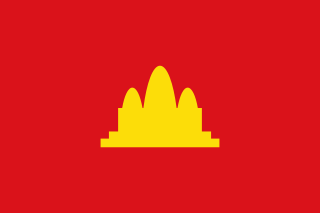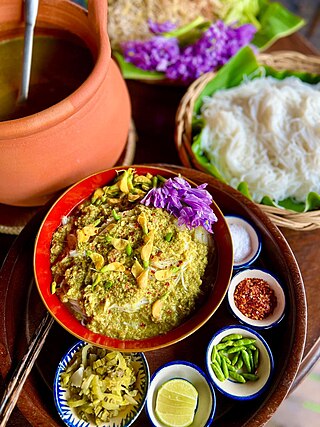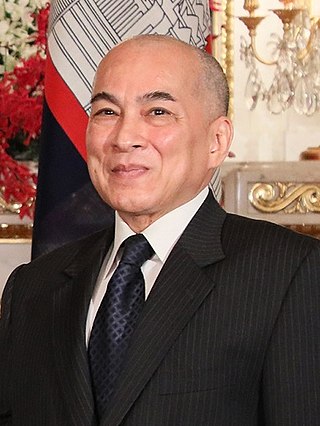This article needs additional citations for verification .(February 2024) |
This is a list of Cambodian films from 2004.
This article needs additional citations for verification .(February 2024) |
This is a list of Cambodian films from 2004.
The history of Cambodia, a country in mainland Southeast Asia, can be traced back to Indian civilization. Detailed records of a political structure on the territory of what is now Cambodia first appear in Chinese annals in reference to Funan, a polity that encompassed the southernmost part of the Indochinese peninsula during the 1st to 6th centuries. Centered at the lower Mekong, Funan is noted as the oldest regional Hindu culture, which suggests prolonged socio-economic interaction with maritime trading partners of the Indosphere in the west. By the 6th century a civilization, called Chenla or Zhenla in Chinese annals, firmly replaced Funan, as it controlled larger, more undulating areas of Indochina and maintained more than a singular centre of power.

The Khmer Rouge is the name that was popularly given to members of the Communist Party of Kampuchea (CPK) and by extension to the regime through which the CPK ruled Cambodia between 1975 and 1979. The name was coined in the 1960s by then Chief of State Norodom Sihanouk to describe his country's heterogeneous, communist-led dissidents, with whom he allied after the 1970 Cambodian coup d'état.

Pol Pot was a Cambodian communist revolutionary, politician and a dictator who ruled Cambodia as Prime Minister of Democratic Kampuchea between 1976 and 1979. Ideologically a Maoist and a Khmer ethnonationalist, he was a leading member of Cambodia's communist movement, the Khmer Rouge, from 1963 to 1997, and served as General Secretary of the Communist Party of Kampuchea from 1963 to 1981. His administration converted Cambodia into a one-party communist state and perpetrated the Cambodian genocide which killed nearly 25% of Cambodia's population.

Phnom Penh is the capital and most populous city of Cambodia. It has been the national capital since the French protectorate of Cambodia and has grown to become the nation's primate city and its economic, industrial, and cultural centre. Before Phnom Penh became capital city, Oudong was the capital of the country.

Norodom Sihanouk was the King and Prime Minister of Cambodia. In Cambodia, he is known as Samdech Euv. During his lifetime, Cambodia was under various regimes, from French colonial rule, a Japanese puppet state (1945), an independent kingdom (1953–1970), a military republic (1970–1975), the Khmer Rouge regime (1975–1979), a Vietnamese-backed communist regime (1979–1989), a transitional communist regime (1989–1993) to eventually another kingdom.

Angkor Wat is a Hindu-Buddhist temple complex in Cambodia. Located on a site measuring 162.6 hectares within the ancient Khmer capital city of Angkor, it is considered the largest religious structure in the world by Guinness World Records. Originally constructed in 1150 CE as a Hindu temple dedicated to the deity Vishnu, it was gradually transformed into a Buddhist temple towards the end of the century.

Cambodia, officially the Kingdom of Cambodia, is a country in Mainland Southeast Asia. It borders Thailand to the northwest, Laos to the north, Vietnam to the east, and has a coastline along the Gulf of Thailand on the southwest. It spans an area of 181,035 square kilometres, and has a population of about 17 million. Its capital and most populous city is Phnom Penh.

The Cambodian Civil War was a civil war in Cambodia fought between the forces of the Communist Party of Kampuchea against the government forces of the Kingdom of Cambodia and, after October 1970, the Khmer Republic, which had succeeded the kingdom.

Samdech Hun Sen is a Cambodian politician, and former army general who currently serves as the president of the Senate. He previously served as the prime minister of Cambodia from 1985 to 2023. Hun Sen is the longest-serving head of government in Cambodia's history. He is the president of the Cambodian People's Party (CPP), which has governed Cambodia since 1979, and has served as a member of the Senate since 2024. His full honorary title is Samdech Akka Moha Sena Padei Techo Hun Sen.

Khmer cuisine combines the culinary traditions of many different ethnic groups in Cambodia, an important subset of which is Khmer cuisine, the nearly-two-thousand-year-old culinary tradition of the majority Khmer people. Over centuries, Cambodian cuisine has incorporated elements of Indian, Chinese, Portuguese and French cuisine, and due to some of these shared influences and mutual interaction, it has many similarities with the cuisines of Central Thailand, and Southern Vietnam and to a lesser extent also Central Vietnam, Northeastern Thailand and Laos.

Norodom Sihamoni is King of Cambodia. He became King on 14 October 2004, a week after the abdication of his father, Norodom Sihanouk.

The monarchy of Cambodia refers to the constitutional monarchy of the Kingdom of Cambodia. The King of Cambodia is the head of state and head of the ruling Royal House of Norodom. In the contemporary period, the king's power has been limited to that of a symbolic figurehead. The monarchy had been in existence since at least 68 AD except during its abolition from 1970 to 1993. Since 1993, the king of Cambodia has been an elected monarch, making Cambodia one of the few elective monarchies of the world. The king is elected for life by the Royal Council of the Throne, which consists of several senior political and religious figures. Candidates are chosen from among male descendants of King Ang Duong who are at least 30 years old, from the two royal houses of Cambodia.
The Cambodia national association football team is the men's national football team that represents Cambodia in association football. It is affiliated with the Asian Football Confederation (AFC) and the regional ASEAN Football Federation (AFF). The team was founded in 1954 and is administered by the Football Federation of Cambodia (FFC).

The Khmer people are an Austroasiatic ethnic group native to Cambodia. They comprise over 95% of Cambodia's population of 17 million.They speak the Khmer language, which is part of the larger Austroasiatic language family alongside Mon and Vietnamese.

The Cambodian–Vietnamese War was an armed conflict between Democratic Kampuchea, controlled by Pol Pot's Khmer Rouge, and the Socialist Republic of Vietnam. The war began with repeated attacks by the Liberation Army of Kampuchea on the southwestern border of Vietnam, particularly the Ba Chúc massacre which resulted in the deaths of over 3,000 Vietnamese civilians. On 23 December 1978, 10 out of 19 of the Khmer Rouge's military divisions opened fire along the shared Southwestern borderline with Vietnam with the goal of invading the Vietnamese provinces of Đồng Tháp, An Giang and Kiên Giang. On 25 December 1978, Vietnam launched a full-scale invasion of Kampuchea, and subsequently occupied the country in 2 weeks and removed the government of the Communist Party of Kampuchea from power. In doing so, Vietnam put an ultimate stop to the Cambodian Genocide, which had most likely killed between 1.2 million and 2.8 million people — or between 13 and 30 percent of the country’s population.

Buddhism in Cambodia or Khmer Buddhism has existed since at least the 5th century. In its earliest form it was a type of Mahāyāna Buddhism. Today, the predominant form of Buddhism in Cambodia is Theravada Buddhism. It is enshrined in the Cambodian constitution as the official religion of the country. Theravada Buddhism has been the Cambodian state religion since the 13th century. As of 2019 it was estimated that 97. 1 percent of the population are Buddhists.

Democratic Kampuchea was the Cambodian state from 1975 to 1979, under the totalitarian dictatorship of Pol Pot and the Communist Party of Kampuchea (CPK), commonly known as the Khmer Rouge. It was established following the Khmer Rouge's capture of the capital Phnom Penh, effectively ending the United States-backed Khmer Republic of Lon Nol. After Vietnam took Phnom Penh in 1979, it was disestablished in 1982 with the creation of the CGDK in its place.

The People's Republic of Kampuchea (PRK) was a partially recognised state in Southeast Asia which existed from 1979 to 1989. It was a satellite state of Vietnam, founded in Cambodia by the Vietnamese-backed Kampuchean United Front for National Salvation, a group of Cambodian communists who were dissatisfied with the Khmer Rouge due to its oppressive rule and defected from it after the overthrow of Democratic Kampuchea, Pol Pot's government. Brought about by an invasion from Vietnam, which routed the Khmer Rouge armies, it had Vietnam and the Soviet Union as its main allies.

The Cambodian genocide was the systematic persecution and killing of Cambodian citizens by the Khmer Rouge under the leadership of Prime Minister of Democratic Kampuchea, Pol Pot. It resulted in the deaths of 1.5 to 2 million people from 1975 to 1979, nearly 25% of Cambodia's population in 1975.
The COVID-19 pandemic in Cambodia was a part of the ongoing worldwide pandemic of coronavirus disease 2019 caused by severe acute respiratory syndrome coronavirus 2. The first imported case in Cambodia was detected in Sihanoukville on 27 January 2020. Although a number of imported cases and transmission to direct contacts were confirmed throughout 2020, no community transmission was detected until 29 November 2020. As of July 2021, Phnom Penh has been the most affected province with the majority of infections and deaths. Banteay Meanchey has the second-highest number of infections, whereas Kandal has second-highest number of deaths.